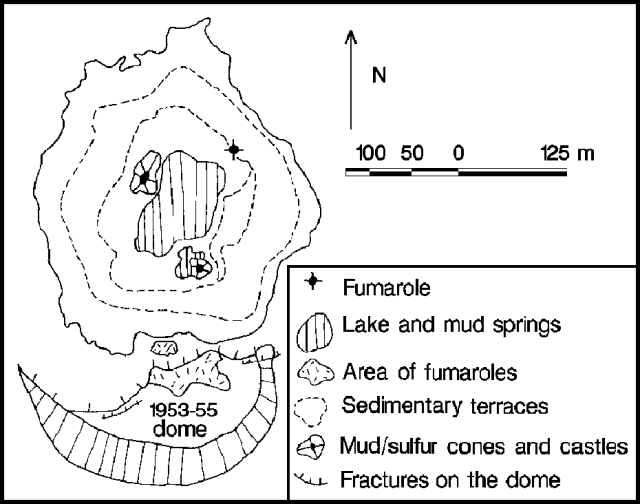Report on Poas (Costa Rica) — June 1990
Bulletin of the Global Volcanism Network, vol. 15, no. 6 (June 1990)
Managing Editor: Lindsay McClelland.
Poas (Costa Rica) Vigorous fumarolic activity but no phreatic explosions; seismicity decreases
Please cite this report as:
Global Volcanism Program, 1990. Report on Poas (Costa Rica) (McClelland, L., ed.). Bulletin of the Global Volcanism Network, 15:6. Smithsonian Institution. https://doi.org/10.5479/si.GVP.BGVN199006-345040
Poas
Costa Rica
10.2°N, 84.233°W; summit elev. 2697 m
All times are local (unless otherwise noted)
Activity at Poás remained low during June, with small explosions and ejections of mud from individual fumaroles but none of the mud eruptions observed in prior months. The small lake at the center of the crater was composed of boiling mud pots fed by subsurface fumarolic activity. There were only minor fluctuations in lake level. Sulfur was precipitated throughout the crater, forming a surface layer on the lake, and was observed to form a floating mat of sediment in early June. Around the periphery of the lake were 3 centers of fumarolic activity, to the NE, NW, and SE (figure 32). The SE group was characterized by boiling mud springs, fumaroles, mud/sulfur cones, and yellow to pale green sulfur flows. One of the NE fumaroles emitted yellow gases (predominantly native sulfur, water vapor, and other sulfur species) at high pressure, producing a jet engine noise. Flames were occasionally seen emerging from the fumarole. Small, occasionally audible, explosions from the NW fumaroles ejected blebs of mud and sulfur, and small blocks to 20 m height. Fumaroles on the N part of the 1953-55 dome had maximum temperatures of 91.5°C. The gas cloud principally traveled W and SW, and continued to cause intense acid rain on the flanks of the volcano.
The Univ de Costa Rica recorded an average of 192 low-frequency (B-type) earthquakes/day and a total of four high-frequency (A-type) earthquakes during the first 12 days of June. These were lower levels than previous months (337 B-type earthquakes/day in March, 301/day in April, and 325/day in May; there were 3 A-type earthquakes/day in May).
Geological Summary. The broad vegetated edifice of Poás, one of the most active volcanoes of Costa Rica, contains three craters along a N-S line. The frequently visited multi-hued summit crater lakes of the basaltic-to-dacitic volcano are easily accessible by vehicle from the nearby capital city of San José. A N-S-trending fissure cutting the complex stratovolcano extends to the lower N flank, where it has produced the Congo stratovolcano and several lake-filled maars. The southernmost of the two summit crater lakes, Botos, last erupted about 7,500 years ago. The more prominent geothermally heated northern lake, Laguna Caliente, is one of the world's most acidic natural lakes, with a pH of near zero. It has been the site of frequent phreatic and phreatomagmatic eruptions since an eruption was reported in 1828. Eruptions often include geyser-like ejections of crater-lake water.
Information Contacts: G. Soto, ICE; Mario Fernández and Hector Flores, UCR.


